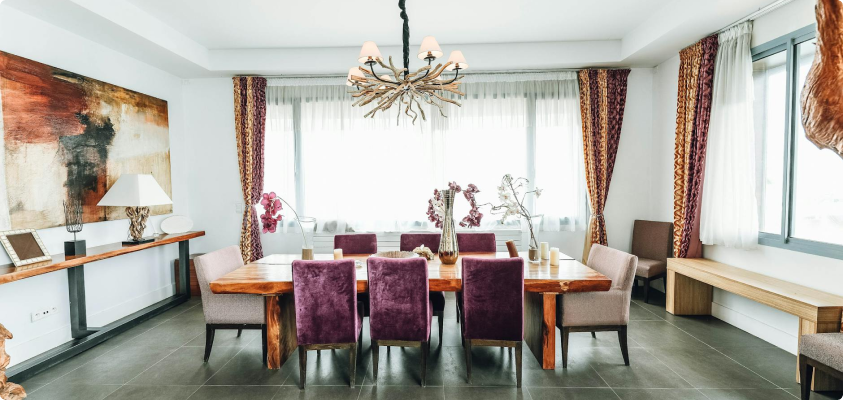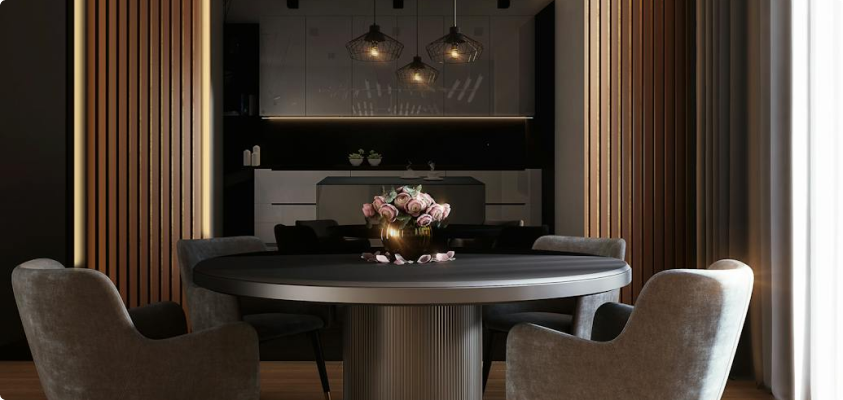1. Understand the Types of Lighting
Ambient Lighting: Provides overall illumination for a room. It’s the primary light source and ensures the space is evenly lit.
Task Lighting: Focuses on specific areas where tasks are performed, such as reading, cooking, or working.
Accent Lighting: Highlights particular features or objects in a room, such as artwork, architectural details, or plants.
Decorative Lighting: Adds visual interest and can serve as a focal point or statement piece.
2. Living Room
Lighting Needs:
- Ambient: Use ceiling fixtures, such as chandeliers or recessed lighting, to provide general illumination.
- Task: Add table lamps or floor lamps for reading or other activities.
- Accent: Incorporate wall sconces or track lighting to highlight artwork or architectural features.
- Decorative: Consider a statement chandelier or pendant light as a focal point.
Tips:
- Dimmer Switches: Install dimmers to adjust the lighting based on the time of day or mood.
- Layered Lighting: Combine different types of lighting to create a balanced and versatile lighting scheme.
3. Kitchen
Lighting Needs:
- Ambient: Install ceiling-mounted fixtures or recessed lights to provide overall illumination.
- Task: Use under-cabinet lighting to illuminate countertops and work areas. Pendant lights over the island or bar area can also be effective.
- Accent: Add lighting to highlight architectural elements or decorative features, such as a backsplash.
Tips:
- Bright and Functional: Ensure task lighting is bright enough for meal preparation and cooking.
- Adjustable Fixtures: Use adjustable fixtures to direct light where it’s needed most.
4. Dining Room

Lighting Needs:
- Ambient: Use a central chandelier or pendant light to provide general illumination for the entire room.
- Task: Ensure the light above the dining table is bright enough for eating and entertaining.
- Accent: Consider adding dimmable wall sconces or table lamps for a warm and inviting atmosphere.
Tips:
- Fixture Height: Hang the chandelier or pendant light approximately 30-36 inches above the dining table for optimal illumination.
- Dimmer Switches: Use dimmers to adjust the lighting for different dining experiences.
5. Bedroom
Lighting Needs:
- Ambient: Use ceiling fixtures or recessed lights for general illumination.
- Task: Add bedside lamps or wall-mounted reading lights for reading and other activities.
- Accent: Use soft, warm lighting to create a relaxing and cozy atmosphere. Consider LED strip lights or sconces.
Tips:
- Adjustable Lighting: Use adjustable fixtures or lamps to control the intensity and direction of light.
- Soft Lighting: Opt for warm, soft lighting to create a calming environment conducive to sleep.
6. Bathroom
Lighting Needs:
- Ambient: Install ceiling-mounted fixtures or recessed lights for general illumination.
- Task: Use vanity lights or sconces around the mirror for clear, shadow-free lighting for grooming and makeup application.
- Accent: Add lighting to highlight features such as a feature wall or decorative elements.
Tips:
- Moisture Resistance: Ensure light fixtures are rated for damp or wet conditions to withstand bathroom humidity.
- Even Lighting: Position task lighting around the mirror to avoid harsh shadows.
7. Home Office
Lighting Needs:
- Ambient: Use ceiling fixtures or recessed lighting for general illumination.
- Task: Add desk lamps or adjustable task lighting to reduce eye strain and improve focus.
- Accent: Consider adding accent lighting to highlight architectural details or personal items.
Tips:
- Bright and Focused: Ensure task lighting is bright and adjustable to focus light on your work area.
- Reduced Glare: Position lights to minimize glare on computer screens and work surfaces.
8. Entryway
Lighting Needs:
- Ambient: Use ceiling fixtures or chandeliers to provide overall illumination.
- Accent: Add wall sconces or table lamps to highlight artwork or decorative elements.
Tips:
- Welcoming Atmosphere: Choose warm, inviting lighting to create a welcoming entry.
- Sufficient Light: Ensure the entryway is well-lit for safety and visibility.
Conclusion
Choosing the perfect lighting for each room involves understanding the different types of lighting and how they can be used to enhance both the functionality and aesthetics of your space. By selecting appropriate fixtures and incorporating a mix of ambient, task, accent, and decorative lighting, you can create a well-lit, inviting, and functional environment in every room of your home.
